The dumbbell row is one of the best exercises to strengthen the back and has been used by bodybuilders of all time such as Dorian Yates, Branch Warren or Ronnie Coleman. Each bodybuilder has his own style to execute the correct form of the row, so you too can find your own variation or way of doing it. This exercise allows you to carry quite heavy dumbbells, so be prepared to strengthen your back, biceps and forearms. Learn all the secrets of this exercise.
What muscles does dumbbell rowing work?
The dumbbell row is mainly used to obtain greater thickness in the back muscles. This row is usually included as a secondary or variant exercise in muscle-building routines for the back. The exercise is also known as unilateral dumbbell row or one-handed dumbbell row. What muscles does the dumbbell row work?
Main:
- • Broad back .
- • Teres major and minor .
- • Infraspinatus .
Secondary:
- • Trapezius.
- • Posterior deltoid.
- • Biceps brachii and brachioradialis.
- • ABS.
This exercise also develops hand and forearm strength.
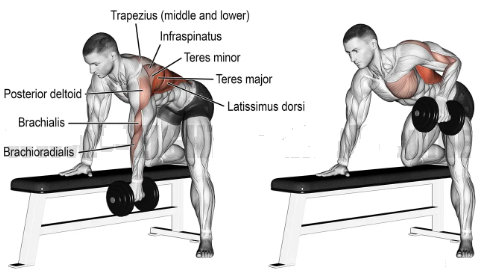
Main benefits of dumbbell row
If you do dumbbell rows regularly, you will get the following benefits:
- • Build a denser and stronger back . It is one of the best exercises to get more thickness in your back. You will work the latissimus dorsi, posterior deltoid, teres major, trapezius and rhomboids. You will improve the strength of your back and arms.
- • Exercise activates other muscle groups in the trunk . Although the movement is mainly used to work the back, the chest, abdominals, lower back, biceps, triceps and even the glutes are also involved.
- • Helps you keep your back straight on a daily basis . Dumbbell rows are also one of the best exercises to improve posture. When the muscles are strong, the spine remains straight.
- • Free weight movement and unilateral work . The one-arm dumbbell row allows you to focus the movement entirely on the right or left side of the body, which avoids muscle and strength decompensations. Pulling the dumbbell with one hand is a very free and natural movement. This exercise gives you even more range of motion than the basic barbell row exercise. The exercise is excellent for improving mobility of the shoulders and elbows.
- • Transfer of strength to other movements . This exercise strengthens the back, biceps and forearms, which are involved in other basic movements such as the squat, deadlift and bench press. Additionally, the dumbbell row could serve as an auxiliary exercise to improve weightlifting movements. The movement helps improve the strength of your other lifts.
- • Increase your grip capacity . You will have stronger hands, a very useful quality for moving more weight in all other bodybuilding exercises.
How to Do Unilateral Dumbbell Rows with Correct Technique
First, you should know that this exercise has different variants , which we will talk about later. The movement that we consider the most basic is the dumbbell bench row. To perform the exercise, you only need a straight horizontal bench.
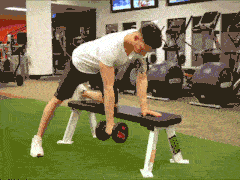
1. Starting position : Stand on one side of the flat bench and rest one knee on the bench. Also rest your arm on the bench. Position yourself so that your back is horizontal with respect to the ground. Bend the other leg a little to lower your body. The dumbbell should be below your body. Grip the dumbbell tightly with your free arm. This arm must be in a vertical position and completely straight.
*Note: If you want your back to be completely horizontal, you can straighten your leg to move your foot away from the bench. This can improve your support points, make your back more horizontal and allow you to apply more force. Some people are more comfortable doing the exercise this way.
2. Execution of the movement : Keep your eyes forward, take a breath and, starting with your arm straight, use the strength of your dorsal to pull the dumbbell towards your torso. The upward movement is not exactly straight; As you raise the dumbbell, you should direct your elbow toward your hip. This is the way to correctly isolate the dorsal in this exercise. The concentric phase should end when your elbow is in line with or above your torso, or when the dumbbell touches your belly. Exhale at this time.
3. Descent : In a controlled manner, lower the dumbbell again until the arm is completely straight to stretch the dorsal well. Take another breath and prepare to do the next repetition.
Remember not to lose tension in the dorsal muscle during the movement.
Dumbbell rowing variants and tips
There are a few ways to do this exercise and several variants that could be interesting to look for different workouts. Let's look at the best known ones.
Rest-Pause Dumbbell Row
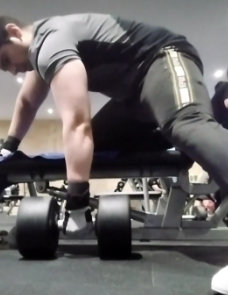
The one-hand dumbbell row is a perfect exercise to apply this technique, which will allow you to take your sets much further to maximize gains. In the conventional version of the exercise, the dumbbell remains suspended in the air from the first repetition and for the rest of the set (the dumbbell does not touch the floor). However, you will soon notice that your grip is usually the first to fail with this technique. This method consists of applying a "rest-pause" to be able to continue doing repetitions when your grip has failed.
Let's say you've completed 10 repetitions with the dumbbell suspended in the air. Then, your grip fails. It will be time to put the weight on the floor, readjust your grip, wait a few seconds and raise the dumbbell again to complete another repetition. You will notice that if you put the dumbbell back on the floor, you will be able to do more repetitions. You could even complete 10 more repetitions when your grip is not too tight in the normal set. Therefore, a set that was 10 reps can become a set of 20 reps to provide double the hypertrophy and strength work. This works especially well when you're doing the horizontal row with heavy dumbbells .
Remember, let the dumbbell rest on the floor, breathe for a few seconds, and do another rep. You can apply this as many times as you want until your muscles can't take it anymore.
Standing Dumbbell Row
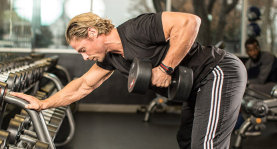
This exercise does not require a weight bench. The movement is similar to the bench version, but is done standing. You will need something to support a hand. Many people choose to rest their hand on the dumbbell rack, although you can also hold onto a power rack or the back of a bench.
• Rest one arm on the dumbbell rack or any other structure in the gym. Bend your legs and lean your body forward a little. Hold a dumbbell with your other arm, which will be suspended vertically.
• Look forward, take a breath and pull the dumbbell up and bring it to your torso. To do the strength with the dorsal, the movement of the dumbbell should not be vertical, but rather should describe a curve (you have to try to pull the weight with your back and not with your arm; you have to bring your elbow towards your hips ).
• When the dumbbell touches your body and your elbow is above your torso, exhale. Then, drop your arm back to the starting position, describing the same curve as when you raised the dumbbell. At the end of the repetition, the arm should be straight again.
The disadvantage of this version of the dumbbell row is that it does not allow you to apply the "rest-pause" technique that we explained previously.
Two-handed dumbbell row
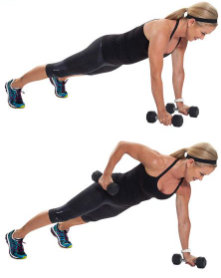
The two-handed dumbbell row movement is also called the Renegade dumbbell row . You also don't need a weight bench to do this exercise, since it is performed directly on the floor:
• Grab two dumbbells and place yourself on the floor in the plank position . Keep your legs straight and your torso aligned. The more you open your legs, the more stability you will have. The starting position is similar to a push-up on the floor but holding the dumbbells. Your arms should be completely straight.
• Fill your lungs with air and forcefully bring one of the dumbbells towards your torso while supporting your body with the other hand.
• Release the air when the dumbbell touches your body and lower your arm again to put the dumbbell back on the floor. Take another breath and do the same with the other arm.
Alternate one arm at a time to complete several repetitions. The good thing about this exercise is that it not only strengthens your back, but also your rectus abdominis and obliques. Additionally, it helps develop stability and coordination.
Incline bench dumbbell row
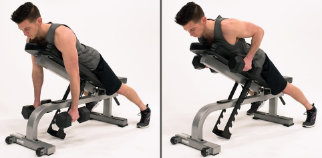
This is another variation that is also done with two dumbbells. You will need an adjustable incline bench.
• You have to tilt a bench at about 45º. Grab a dumbbell in each arm and place yourself on the bench, resting your belly on the backrest. Keep your legs behind you and bent, with your feet in contact with the floor. Start with both arms suspended and completely straight.
• Take a breath and pull the dumbbells until you bring them to your torso. Remember to contract your lats when the dumbbells are as close to your body as possible.
• Exhale when the dumbbells rise close to your body and lower your arms again until they are straight. This way you will have completed one repetition.
You can choose to do one repetition with each arm alternately or raise both dumbbells at the same time. This exercise can also be done with kettlebell weights. This movement favors greater isolation of the dorsal muscle because, thanks to the bench, we do not need central stability or involve the glutes. You can grip the dumbbells with a pronated or neutral grip .
Different styles of dumbbell rows in bodybuilding
If you are a bodybuilding fan and have watched many training videos, you may have noticed that bodybuilders do the dumbbell row in different ways. Which of all is the correct way to do this exercise? All ways are correct! The choice depends on the style of each practitioner. Let's review different styles.
• Row with the dumbbell in a horizontal position : Surely, you have seen many bodybuilders doing the exercise in this way. Instead of gripping the dumbbell in a neutral way, the hand is rotated and positioned almost pronated. In this way, the dumbbell is horizontal and forming a cross with the body.
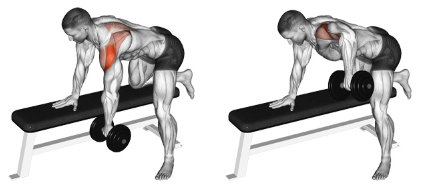
• Dumbbell row with neutral grip : It is the classic way to do the exercise; The dumbbell is gripped with the hand in a neutral position and aligned with the body.
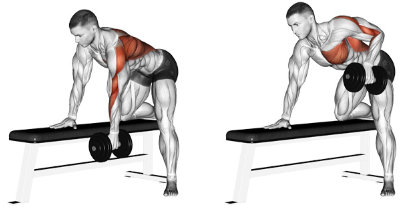
• Rowing with a dumbbell describing a curve : As explained in the execution of the exercise, better isolation of the dorsal muscle is achieved if you describe a curve with your arm when pulling the dumbbell (and directing the elbow towards the hip). However, the movement can also be done in the way we will see below (vertical pull).
.gif)
• Rowing with a dumbbell in a vertical direction : A much simpler alternative that allows you to move more weight. You just have to pull the dumbbell vertically. This version involves the arms more in the movement.

As we see, you can change the position of your hands and the trajectory of the weight in the exercise. Choose the way you prefer or alternate them all.
How much strength can I have in the one-arm dumbbell row?
Progressing to gain strength in the unilateral dumbbell row takes time and dedication. Here are some realistic strength standards for this exercise:
Untrained : 0.15 x body weight x 10 repetitions (1 RM: 0.20 x body weight)
Rookie : 0.25 x body weight x 10 repetitions (1 RM: 0.35 x body weight)
Intermediate : 0.4 x body press x 10 repetitions (1 RM: 0.55 x body weight)
Advanced : 0.6 x body weight x 10 repetitions (1 RM: 0.8 x body weight)
Elite : 0.8 x body weight x 10 repetitions (1 RM: 1.05 x body weight)
The novice person has trained for a few months to a year. The intermediate user has been training for more than two years. The advanced user has trained consistently for over 5 years. Getting to the elite level is not for everyone and will take much longer for most; even 10 years or more of training.
Let's see what the strength standards would be for a 70 kg person.
Untrained : 10 repetitions with 10 kg dumbbell (14 kg 1 RM)
Rookie : 10 repetitions with 17.5 kg dumbbell (24.5 kg 1 RM)
Intermediate : 10 repetitions with 28 kg dumbbell (38.5 kg 1 RM)
Advanced : 10 repetitions with 42 kg dumbbell (56 kg 1 RM)
Elite : 10 repetitions with 56 kg dumbbell (73.5 kg 1 RM)
Everyone should aim for at least the intermediate level , which is already considered a good level of strength. The advanced level is also a good goal.
How can I get strength on the dumbbell bench row?
Would you like to achieve the records that we have cited for this exercise? The first thing is to do the dumbbell row. Although bodybuilding exercises transfer strength from one to another, it is best to regularly do the movement in which you want to progress. So, include this movement in your back routine.
After a warm-up, remember to reserve all your energy for the first set of this exercise , which we will call the "top set". Try to improve on this first main set each time you do the exercise. Start with a dumbbell that you can do about 20 repetitions without problems. In the next workout, increase the weight and grab a dumbbell that is about two kilos heavier. Complete as many repetitions as you can.
Try to increase the weight in each workout until you reach a load that allows you to do only 5 repetitions. Then, it will be time to go back to the dumbbell you used in the first workout and surpass the 20 repetitions you did. Try to beat your records for successive weights, to take your physical strength further and further.
After each "top set", you can do about two more sets of 8 to 12 repetitions to give more work to the lat muscle. Remember to write down all the weights and repetitions you do on each training day.
When to do the horizontal dumbbell row?
This exercise is usually used as a complement after other more basic movements in a back routine. It is common to do dumbbell rows as a third or fourth exercise . For example, you can start the workout with back pull-ups, follow with a heavy barbell row, continue with lat pulldowns, and then do the dumbbell row and pull-over to finish. It is enough to do this exercise once a week.
Are you also interested in this? :
Athletes who can benefit from this exercise

The following people will find doing one-hand horizontal rows with dumbbells very beneficial :
• Powerlifters and Strongman Competitors : Back strength improvements directly help movements such as pulls, squats, farmer's walks, deadlifts and press.
• Weightlifters : Olympic lifters also need a strong back to do their regular strength movements. Dumbbell rows can be used as an assistance exercise to increase muscle mass, grip strength, and back thickness.
• Bodybuilding and fitness practitioners and athletes from other disciplines : Rowing can help all these athletes to correct unilateral strength imbalances, improve posture and gain hypertrophy. Additionally, rowing can be a great assistance exercise for deadlifts, pull-ups, or any strength exercise that involves the upper body.
• Any gym user : Anyone without competitive goals can benefit from this exercise. The movement is adaptable to people of all training levels.
Common mistakes in this exercise
Try to avoid the following common mistakes when performing dumbbell rows.
• Hunching the chest and shoulders : Avoid this gesture because then you will not be focusing effectively on the back muscles. Do not adopt a slouched posture.
• Using too much weight : Leave heavy dumbbells for when you have experience (and a strong back and shoulders). If you are a beginner, focus on technique. To avoid cheating, you can do the incline bench version of the dumbbell row.
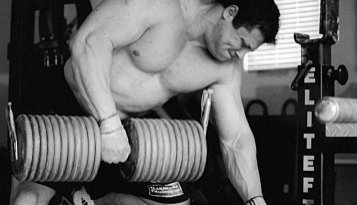
• Use your legs to move the weight : It is important that your lower extremities and hips are still during the exercise, once you have adopted the correct posture. You should not bend over or use your lower body to gain momentum and help you lift the weight. You must focus on the muscles you want to work (the back) for the exercise to be effective.
• Leaning too far : Don't lean too far forward. About 45º will be enough. If you bend over more, you could hurt your back if you use heavy dumbbells. However, you may find it helpful to hyperextend your lower back a little; This will help prevent the spine from bending.
• Bending the wrists : Another common mistake is bending the wrists up, down or to the sides. Try to avoid this and try to keep the joint as still as possible during the execution of the movement. You can use muscle training wristbands to avoid strain on your wrists.
Do not do one-hand dumbbell rows if you suffer from lower back pain . Be especially careful when you are advanced and use heavy loads. Very heavy dumbbells could cause shoulder impingement in this exercise. Always use the correct technique that we have explained. Also, if you experience pain in your shoulders or back when rowing, stop doing the exercise immediately and consult a doctor. When you master the technique and movement control well, you will be able to increase the load to move heavier weights.
Difference between one-handed horizontal row with dumbbells and two-handed rows
You can do two-handed dumbbell rows to train your back much faster. The exercise simply requires less time when working with both arms at once.
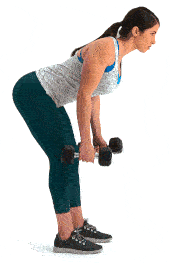 |
| Variant of the standing exercise, without a bench and with two hands. |
However, the one-handed unilateral dumbbell row allows you to move more weight. This is because the one-handed version does not require the stabilizing strength of the hamstrings and lower back. The dumbbell row with your knee supported and one arm on the bench offers more support, allows you to use heavier dumbbells and take your sets to muscular failure.
One problem with doing dumbbell rows without a bench is that the lower back muscles may fatigue first and not the middle and upper back (what you are really looking to strengthen). If this happens to you, do the exercise while resting on a flat bench, as this is the version that offers greater muscle isolation, safety, and allows you to work better.
In case you want to do the exercise with both hands at the same time, an efficient way to isolate the dorsal is to do the dumbbell row supported on an incline bench .
Material and tricks for lifting heavy in horizontal rows with dumbbells
Here is the material you need to do the dumbbell bench row .
• Flat weight bench . If you want to do the exercise with your chest supported, you will need the adjustable bench (with inclination).
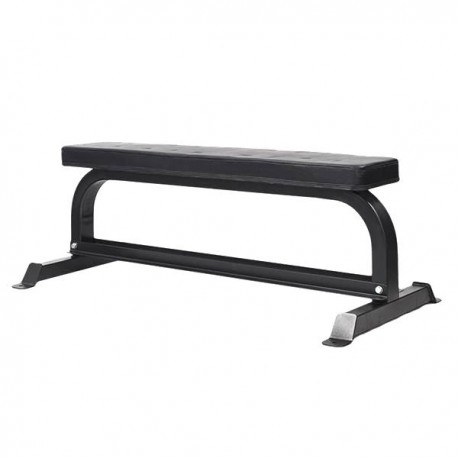
• Dumbbell : You can use three types.
- Fixed dumbbell . This type is in all commercial gyms. They are dumbbells mounted with a certain weight.
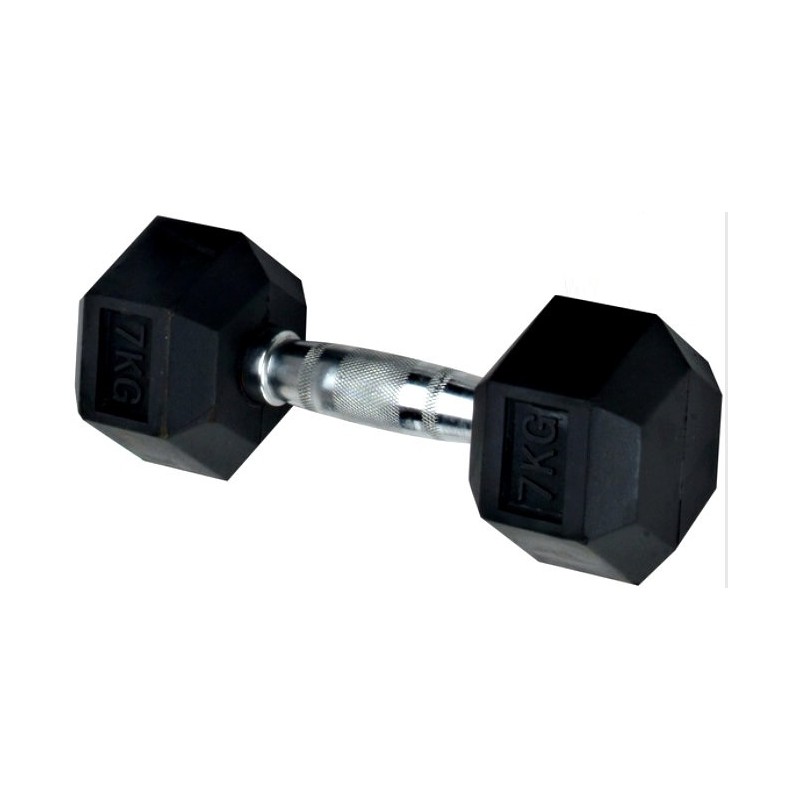
- Mountable dumbbell . It is a bar in which you can add the weight plates you want. It has the disadvantage that you will have to assemble and disassemble it to change weight. It is mainly used for training at home.
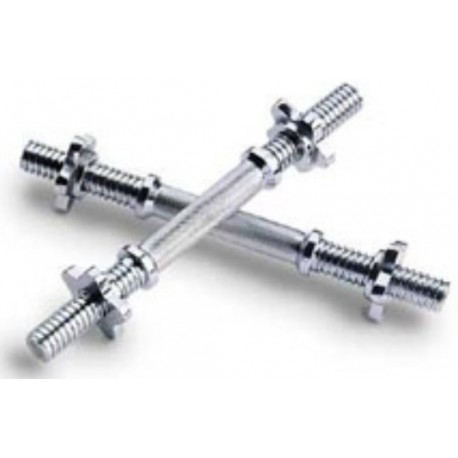
- Automatic dumbbell. It is the most comfortable dumbbell to train at home, although more expensive. You can change the weight automatically.
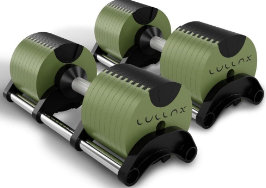
How to improve strength and grip?
Here are some tools that will help you improve your grip and performance to lift more weight:
• Magnesium and gloves : Use these items to improve your hand strength and not have to worry about your grip. The most comfortable thing to train in a gym is liquid magnesium.

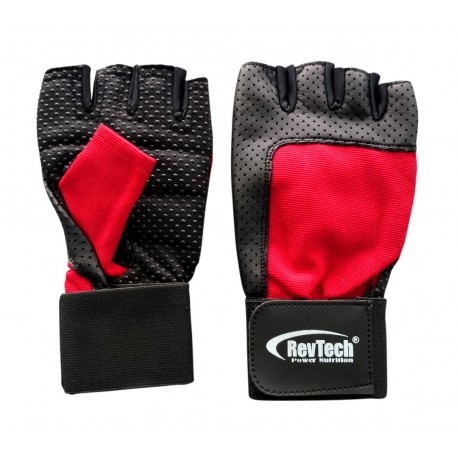
• Wristband with straps : The strap goes around the handle of the dumbbell to help hold it. This is a good option to be able to lift more weight when you have a weak grip. You have to know how to use the strap.
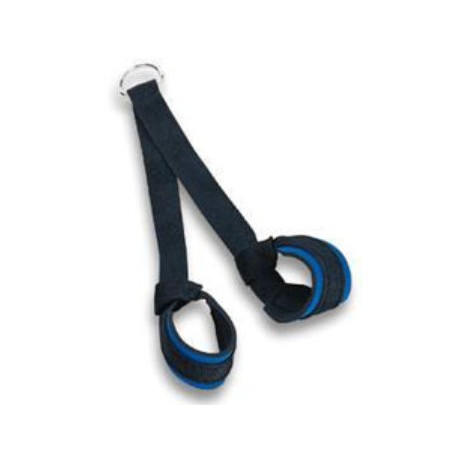
• Weight lifting belt : This accessory makes the back and abdomen more compact and, therefore, you can apply more force.

Put this fantastic exercise into practice today, which you can do with all the variants that have been detailed. Do bilateral or unilateral dumbbell rows. The best thing to gain hypertrophy is to work this exercise in a range between 30 and 5 repetitions. Maximize your gains with different weights. Are you able to reach the intermediate level of strength?









